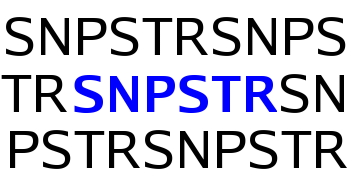





WHAT DATABASE ACCESSION NUMBERS CAN BE USED?
SNPSTRs can be searched by
- SNPSTR ID
This is of the form "SNPSTR####" where #### is a number
e.g. SNPSTR2229
- SNP ID
This is of the form "rs####" where #### is a number.
RS identifiers were chosen (and not SS identifiers) since they refer to genomic position rather than specific entries. These identifiers came from the NCBI and ENsembl databases.
e.g. rs4845994
- GENE OR PROTEIN ID
Since many different identifiers exist from different databases for a gene location, there are many ids that can be used:
- Ensembl gene id: this is of the form ENSG##### where #### is a number
e.g. ENSG00000181585
- HUGO gene name or HGNC gene id: HUGO gene name consists of letters and numbers and it the closest thing to a universally accepted gene name. HGNC consists of numbers of only.
e.g. HUGO name: TMIE (for this gene HGNC number is 30800)
- EntrezGene gene id: Entrez Gene ids were included in the database so that SNPSTRs can be linked to from the NCBI database as well. Entrezgene id is of numerical form
e.g. 259236
- Uniprot protein id: these ids are a micture of letters and numbers
e.g. Q8NEW7
- PUBMED: some of the genes have linked Pubmed ids so these were included in the database in case one wants to search with these ids.
e.g. 12140191
- OMIM ID
Genes are linked to diseases so some of the SNPSTRs are contained in disease genes. The database can be searched by OMIM disease ID or OMIM disease gene ID, both of which consist
only of numbers.
e.g. disease gene 603537 is related to disease 600101
WHY IS THERE A SEARCH AND A DOWNLOAD BUTTON?
By default the results are displayed as HTML which is great when one is looking for a small number of SNPSTRs. However when more than a few SNPSTRs are being looked at, the HTML
format is not very useful. In addition, one might want to get the information in a format which can be easily manipulated for example, one my want to input the data into a Perl
Script for further research, something that HTML output would not allow.
For this reason, the database interface provides the option of downloading the data rather than viewing
them. The user can choose if he or she wants the file to be tab-delimited or comma-delimited, and when he or she clicks on the download button a window pops up that asks if the
user wants to open the file or save it in their computer. The files contain all the information contained in the HTML page with the exception of the multiple gene accession ids
(only the Ensembl gene ids are provided).



